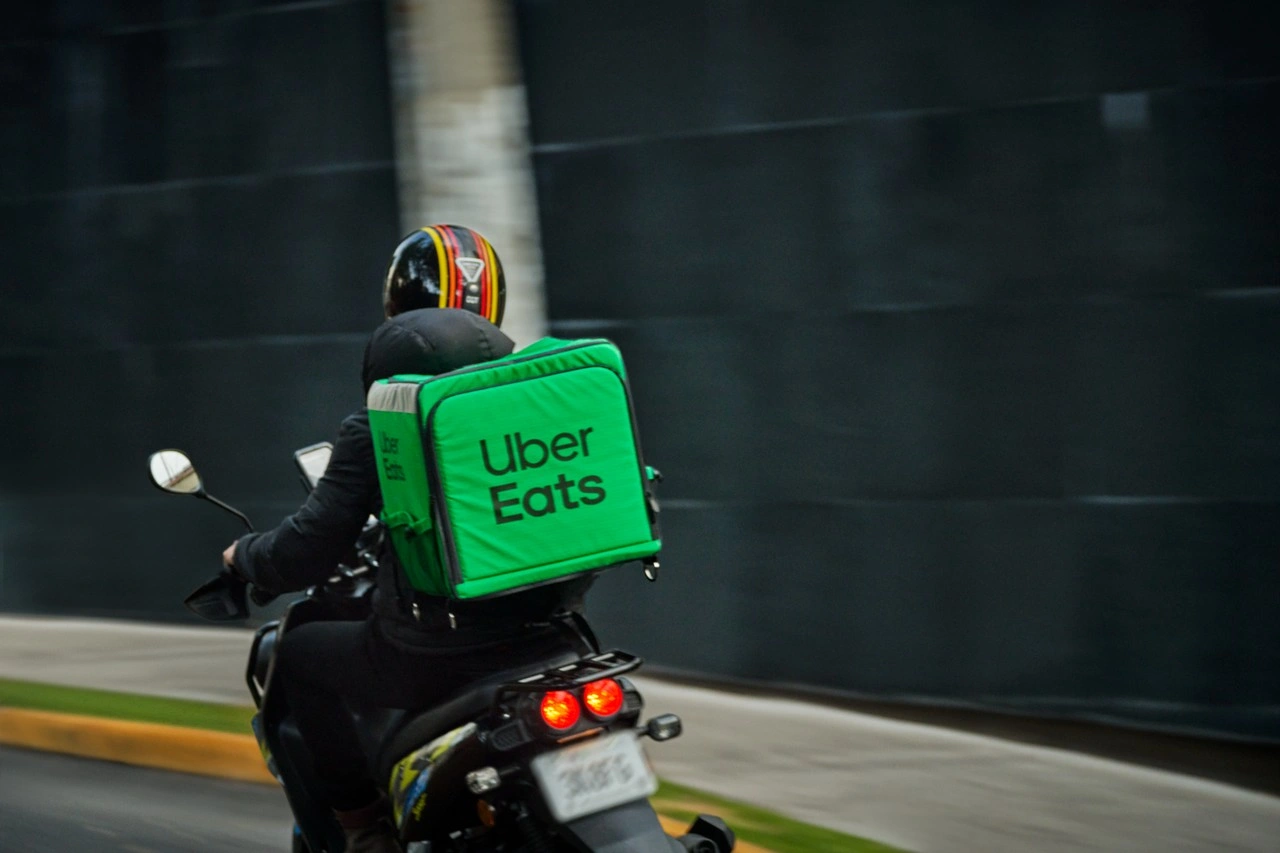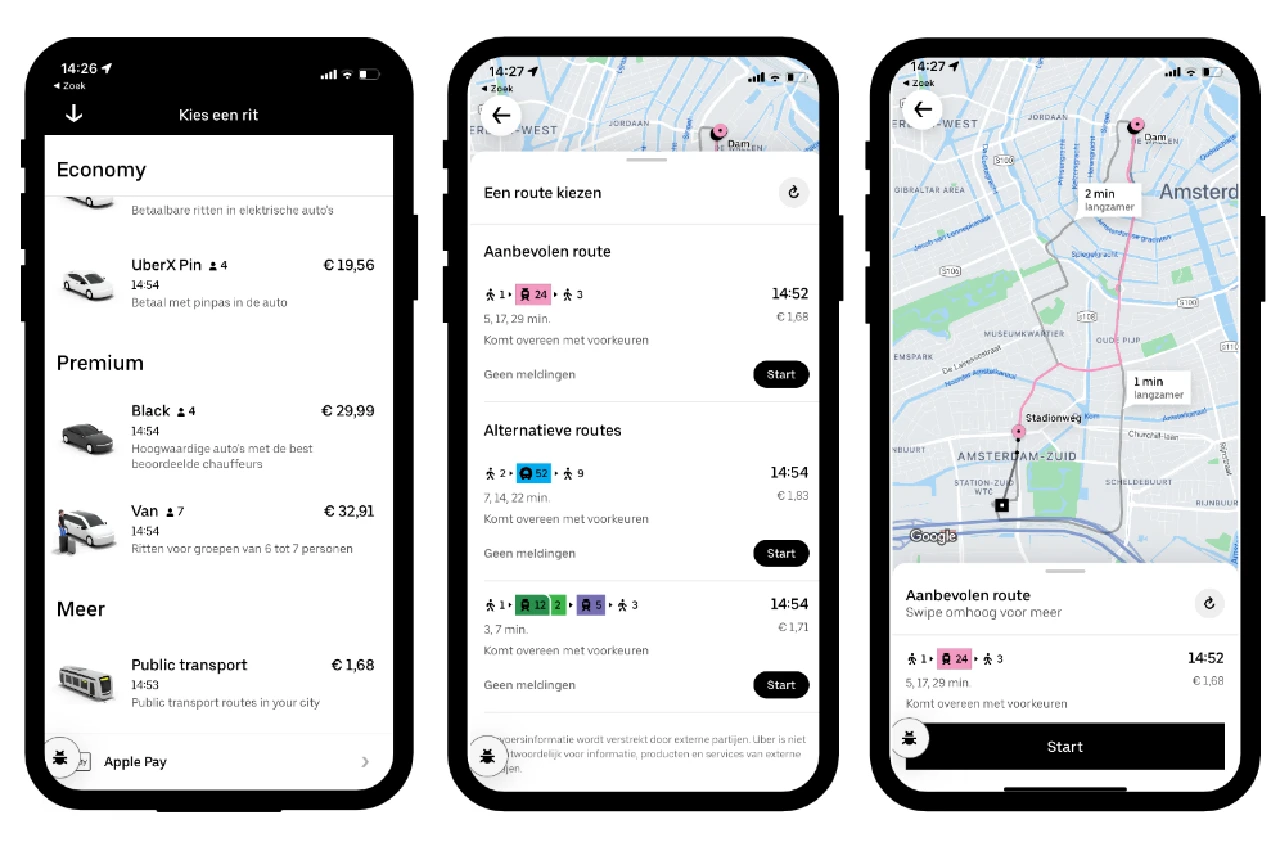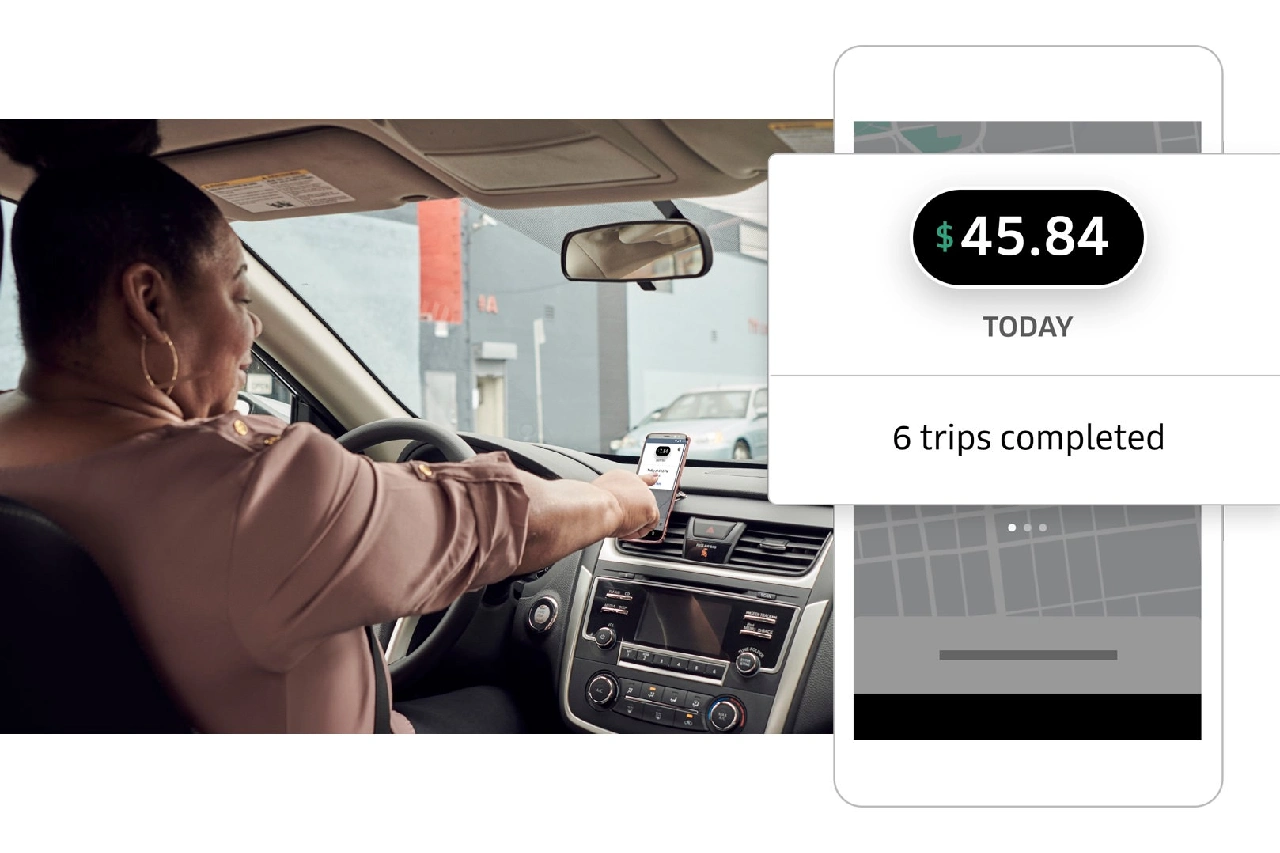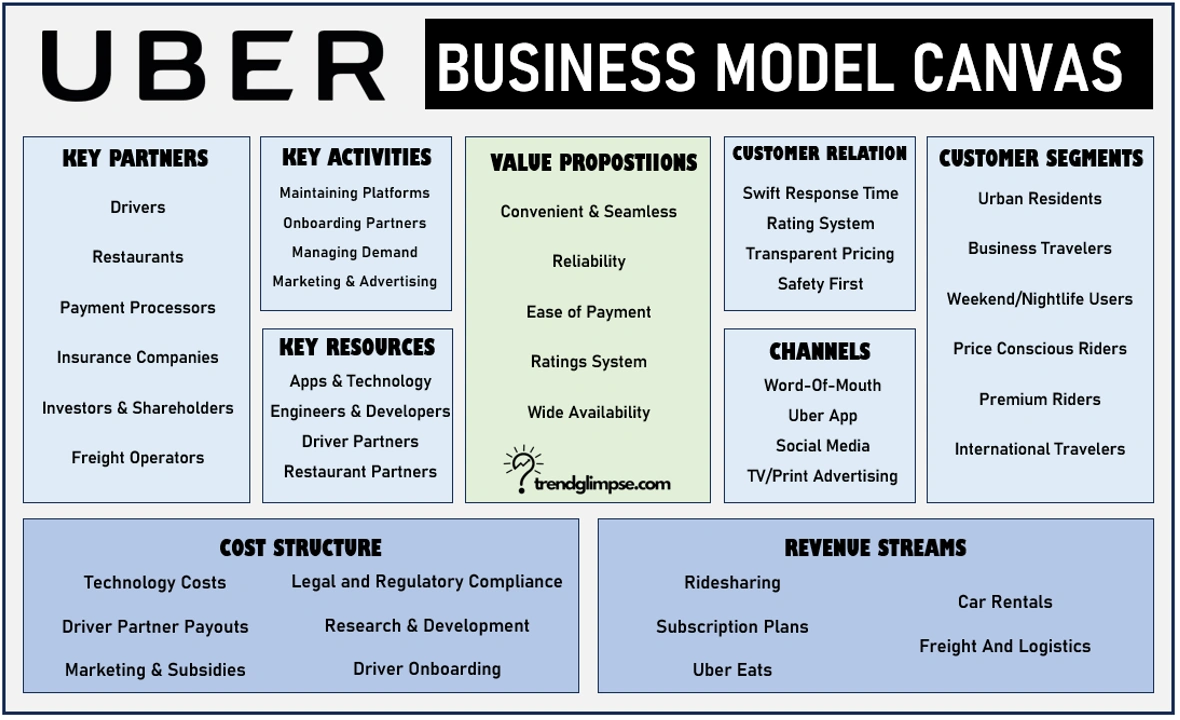An Overview of Uber
Uber rolled out its peer-to-peer ridesharing concept in 2009, and it quickly took off in popularity thanks to its convenience, ease of use, and affordability compared to traditional taxi services. Fast forward to today, and Uber has provided over 10 billion trips worldwide, with an average of 5 million rides per day!
Headquarters: San Francisco, California, United States
Industry: Transportation & Mobility
Current CEO: Dara Khosrowshahi
Annual Revenue [2023]: US$ 31.87 Billion
Employee Count: ~32,800
Website: Uber.com
What makes the Uber model stand out is its use of independent contractors as drivers rather than employees, keeping overhead costs low. Combined with surge pricing during high-demand times, this yields strong revenue and profits for Uber on each ride. The company also continues expanding into new ride offerings, like carpooling and electric bikes and scooters for urban commutes.
Ride-sharing, Uber Eats, Freight & Package Delivery, Uber for Business, Rewards, Rent, Health, Autonomous Vehicles
Brand Portfolio of Uber
Uber Eats, Car Next Door, Cornershop, Drizly, Postmates, Careem (2020-2023)
Competitiors of Uber
Lyft, Didi Chuxing, Ola, Grab, Curb, Via, Juno, Gett, Careem, Bolt, Yandex.Taxi, Easy Taxi, Gojek, BlaBlaCar, DiDi Express, Cabify, Mytaxi
In this article we will examine an article discussing Uber’s innovative business model. It provides an in-depth look at how Uber’s technology platform and operations have enabled rapid growth while also raising concerns around driver wages and rider safety.
Business Segment of Uber

Mobility
Uber’s core business is providing ride hailing services through its Mobility segment. This includes the Uber rides service we’re all familiar with, where you can order a car through the app and get picked up and dropped off. Mobility made up $14.03 billion in revenue for Uber in 2022, which was a huge 102% increase over 2021. This growth shows how ridesharing has really bounced back after being hit hard during the pandemic.
Some of the latest trends in Uber’s Mobility business are things like Uber Comfort, which provides mid-range cars with extra legroom, and Uber Green, which lets you request an electric or hybrid vehicle. They’ve also been expanding Uber Transit to include public transportation options in the app.
Delivery
Uber’s delivery service, called Uber Eats, has become a major part of their business over the last few years. Launching in 2014, it lets people order food for pickup or delivery from restaurants in their area. Uber takes a cut of each order as revenue. This segment brought in $10.9 billion in 2022, a 30% jump from the previous year!
As more people have gotten used to ordering delivery during the pandemic, Uber Eats has expanded into groceries, alcohol, convenience items and more. They’ve made some smart acquisitions too, snapping up Postmates, Drizly and Cornershop to strengthen their delivery network.
The delivery segment is important for Uber because it increases consumer engagement and gives drivers more earnings opportunities without needing a special driver’s license. Uber is even offering delivery-as-a-service to retailers through Uber Direct.
Freight
In 2018, Uber expanded into the logistics space with a new business segment called Uber Freight. This online platform matches shippers with truck drivers, allowing them to easily connect and negotiate pricing for shipping freight. It’s basically like their ridesharing model, but for trucks!
Uber Freight has seen rapid growth, with revenues jumping 226% from 2021 to 2022 to reach $6.94 billion. The service simplifies the logistics process for both shippers and drivers by providing an on-demand digital marketplace to automate transactions. It offers upfront pricing, tracking, and other logistics solutions.
Uber Freight serves small businesses up to global enterprises and operates mainly in North America and Europe. Some of the latest trends include partnering with other logistics firms to expand capacity and rolling out app features like faster payments for drivers.
Business Model of Uber
Customer Segment of Uber
Urban Residents
This is Uber’s bread and butter – people who live in cities and use Uber for their everyday transportation needs. Uber is convenient and affordable compared to owning a car or relying on public transport in crowded cities. It fits the on-demand lifestyle and allows urban residents to get around quickly.
According to Uber’s statistics, the company processes 22% of all its gross mobility bookings in only 5 metropolitan areas, including Chicago, Los Angeles, New York City, São Paulo, and London. Additionally, Uber’s collaboration with cities has allowed for unique data analysis using information from over two billion trips in more than 600 cities, which has helped to improve transportation systems and reduce traffic congestion.
Business Travelers
Uber is popular with business travelers who need to get to meetings, conferences, airports, and hotels efficiently. Instead of renting a car or relying on taxis, Uber provides seamless door-to-door service that can be expensed. Business travelers can access rides and meals in over 70 countries, with easy expensing and centralized management through a dashboard.
Uber for Business has emerged as a core unit within Uber’s portfolio, with over 170,000 customers across 70+ countries. The platform provides tools for monitoring travel expenses, in-app budget controls, and travel policy controls, allowing organizations to take control of their corporate travel and provide employees with a smooth Uber experience.
Weekend/Nightlife Users
The use of Uber is popular among people going out for nightlife and weekend activities. Many individuals rely on Uber to travel to and from entertainment and nightlife areas, as well as to socialize without the need to drive themselves, especially to avoid the risk of driving under the influence.
For example, in Los Angeles, urbanites have incorporated Uber into their weekend routines, using it to go to work, socialize, and attend events, allowing them to enjoy the city’s nightlife without the need for a personal vehicle. Additionally, Uber’s data has shown that the service experiences high demand on Friday and Saturday nights, particularly to and from entertainment and nightlife areas.
Price Conscious and Premium Riders
Uber caters to both price-conscious and premium riders, offering a range of options to suit different preferences and budgets. For price-conscious riders, UberX offers more affordable rides, making transportation accessible for a wider range of users. Additionally, UberPool enables two or more riders going in the same direction to share the cost of a ride, further reducing the overall cost. On the other hand, Uber Black provides high-end rides with professional drivers on demand, at premium prices.

Value Proposition of Uber
Convenient & Seamless
One of the main things that makes Uber so popular is how incredibly convenient and seamless the whole experience is. You just tap a few buttons on your phone and within minutes your ride shows up ready to take you wherever you need to go.
No waiting around for a taxi or dealing with public transport schedules. The app makes booking and tracking super straightforward. This on-demand model has really resonated with people and helped fuel Uber’s rapid growth.
Reliability
Another key advantage is reliability. Unlike taxis which can be tough to find when demand is high, the Uber fleet is large enough that you can almost always get a ride within minutes, even on busy nights. The app lets you track your driver’s location too, so you know exactly when they’ll arrive.
For example, in Boston, 96% of trips started within 20 minutes of request across all neighborhoods, with a median wait time of 3.5 minutes. This reliability has helped build tremendous customer loyalty. Moreover, the company has invested in improving its infrastructure, leading to a 30% reduction in search latencies and a 75% reduction in index size for its Uber Eats product.
Ratings System
Uber’s two-way ratings system is another smart innovation that helps ensure quality service. After each trip, drivers and passengers can rate each other from 1 to 5 stars. Poor ratings can get users banned from the platform.
This accountability helps weed out bad behavior and maintain a higher standard of rides. Ratings are anonymous, meaning users won’t see individual ratings tied to a particular trip or person. Uber has also introduced a privacy center, allowing users to access a breakdown of their average ratings, feedback, and compliments.
Wide Availability
Uber’s widespread availability in over 70 countries globally is a major asset. Wherever you go, you can count on having access to Uber’s convenient rides. The scale of their service network creates consistency and has expanded their reach tremendously. Uber’s wide availability is evidenced by its substantial user base and global presence.
In 2022, 131 million people used Uber, marking an 11% increase from the previous year, with approximately 85 million of users utilizing Uber Eats. The service operates in 10,000 cities across 71 countries, and it has 93 million monthly active platform consumers. These figures demonstrate the extensive reach of Uber’s services, making it a widely available transportation and food delivery option for a large and diverse user population.
You might also like – HelloFresh Business Model
Revenue Streams of Uber
Ridesharing
Uber’s core business is still ridesharing, connecting riders with drivers through its app. In 2022, Uber facilitated over 7.6 billion rides worldwide. This shows a 20.6% increase from 2021. Uber maintains a commanding 68% market share of the US rideshare industry.
Uber has pricing power due to its scale and brand recognition. It can increase fares during periods of high demand through surge pricing. Uber also takes a cut from every ride – around 20-30% of total fare value. As Uber’s ride volume grows, so do its revenues.
Subscription Plans
Uber has launched subscription plans like Uber Pass to lock in customer loyalty. For a monthly fee, Uber Pass offers benefits like discounted rides, priority airport pickups, flexible cancellations, and free delivery on Uber Eats orders.
Subscription revenue gives Uber a recurring, predictable income stream. It also incentivizes customers to use Uber more frequently to get the most value from their subscription. As of Q3 2022, Uber reported nearly 5 million Uber Pass subscribers.
Uber Eats
Uber Eats, the company’s food delivery vertical, generated $10.9 billion in gross bookings in 2022, a 31% increase over 2021. Uber Eats has approximately 88 million monthly active users, making it the largest single-app food delivery service globally.
Uber Eats is now present in over 6,000 cities across 45 countries. Its growth has accelerated during the COVID-19 pandemic as home-delivery became essential. Uber is investing heavily to defend its lead in the fiercely competitive food delivery space.
Car Rentals
Uber Rent pairs riders looking to rent vehicles with car owners willing to share their personal vehicles. Users can book cars by the hour or day directly in the Uber app. Uber takes a cut of each rental fee.
Uber is leveraging its large rideshare user base and technology to enter the car rental market. Peer-to-peer car sharing also helps Uber reduce environmental impact by decreasing private car ownership.
Freight And Logistics
Uber Freight links shippers with truck drivers to handle cargo deliveries. It provides real-time tracking, instant pricing, and a seamless experience for both shippers and carriers.
Uber Freight expects to reduce long-haul trucking employment by 3-5% in 2023 through increased efficiency. It is also prioritizing sustainability by eliminating empty miles through better load planning.
By diversifying revenue, Uber aims to establish an ecosystem effect across its platforms. Cross-promotion and bundling create opportunities to unlock growth while deepening customer loyalty. Uber’s scale and tech expertise provide a foundation to expand into multiple transportation verticals.
You might also like – Shake Shack Business Model
Channels of Uber
Word-of-Mouth Marketing
Word-of-mouth marketing has been a key driver of growth for Uber. Satisfied customers tell their friends and family about Uber, which provides free advertising for the company. Uber facilitates word-of-mouth by making it easy to share promo codes and referral links that give discounts to new riders.
Viral growth is amplified as each new Uber customer is likely to refer others. Uber has achieved impressive word-of-mouth through delivering a seamless user experience, competitive prices, and strong brand image. This organic and unpaid growth channel has allowed Uber to scale rapidly.
Uber App
The Uber app itself acts as a customer acquisition channel. It provides visibility to the Uber brand and makes it extremely easy for new users to sign up and request their first ride within minutes. Features like estimated pickup times and driver profiles increase user confidence in the service. App store optimization and search engine marketing drive downloads of the app.
Once downloaded, clever onboarding guides new users through signing up and taking their first trip. The frictionless mobile experience converts casual app users into loyal customers. Uber’s technology and user interface optimize conversion all within the app itself.

Social Media
With over 5 million followers on Facebook and 1 million on Twitter, Uber leverages social media for brand awareness and real-time customer service. Facebook ads target potential riders in new cities while organic posts highlight local events and partnerships.
Twitter is used to broadcast service updates, answer questions, and manage reputation. Uber also partnered with Instagram influencers to promote its services to younger demographics. Paid social helps Uber penetrate new markets while organic social helps manage its brand image.
Key Resources of Uber
Apps and technology
Uber’s mobile app and accompanying technologies are central to its operations and success. The consumer-facing app allows riders to request rides, track drivers, and pay seamlessly. The driver app enables Uber’s network of drivers to accept ride requests, navigate to pickups and destinations, and manage their earnings.
Behind the scenes, Uber leverages complex algorithms and AI to efficiently match drivers to riders, surge price, route vehicles, and more. For example, Uber built an in-house geospatial indexing system called Hexagon to optimize routing and ETA calculations. Uber’s focus on proprietary technology and continuous app innovation helps it stay ahead of competitors.
Engineers and developers
Uber employs thousands of top engineers and developers across its software, research, and product teams. These human resources are critical for designing, building, and maintaining Uber’s complex technology infrastructure and apps. Uber recognizes the importance of technical talent and invests substantially in recruitment, offering high salaries and benefits to attract the best.
Uber’s engineers are constantly innovating to improve ride matching, mapping, pricing algorithms, and launching new products like food delivery. The company culture empowers engineers to experiment and take risks.
Driver partners
Uber’s network of over 4 million driver partners globally is core to its operations and growth. These independent contractors choose when and where to drive using their own vehicles. Uber conducts background checks and requires documentation to onboard qualified drivers. The driver app allows partners to easily accept ride requests, earn income, and track their trips and earnings.
The company knows maintaining a large, reliable driver fleet is critical for providing sufficient supply to meet rider demand. Uber analyzes data to predict driver availability in various locations and dynamically prices rides to get more drivers on the road during busy times.
Restaurant partners
Uber Eats has over 500,000 restaurant partners globally. These restaurants rely on Uber Eats to provide food delivery services for their customers. Uber Eats provides the technology platform and logistics network to facilitate these deliveries in a convenient, reliable way. The commission fees charged by Uber Eats can be a source of tension with restaurants though.
The Uber Eats’ 2023 Merchant Impact Report provides insights into the impact of the platform on small and medium-sized restaurants, with over 30,000 of these businesses partnering with Uber Eats. The report highlights that more than 60% of merchants on the Uber Eats platform are small and medium-sized businesses, and the app has directly added over £2 billion in net restaurant revenues in the last year.
You might also like – Starbucks Business Model
Key Activities of Uber
Maintaining Mobile Apps and Technology Platforms
Uber relies heavily on its mobile apps and technology platforms to connect riders with drivers. The company invests significant resources into developing and maintaining its apps to ensure a seamless user experience.
For example, in 2019 Uber rebuilt its rider app from the ground up to improve performance and add new features like public transit integration. On the driver side, the company frequently rolls out app updates to optimize the pickup process and provide more earnings opportunities. Staying on the cutting edge of mobile technology is critical for Uber to retain its competitive position in the market against rivals like Lyft.
Managing Demand Prediction Algorithms
Uber utilizes sophisticated demand prediction algorithms to efficiently match rider demand with driver supply. The algorithms analyze historical ride data to forecast where and when heightened demand will occur. This allows Uber to implement surge pricing and provide incentives to get more drivers on the road for busy times and locations.
Fine-tuning these algorithms is essential so wait times are minimized and drivers earn optimal fares. For example, improving demand prediction for airports has enabled Uber to better time driver supply for flight arrivals and departures. More accurate demand forecasting contributes to a better rider experience and more profitable driver earnings.
Marketing And Advertising
Uber invests heavily in marketing and advertising to promote its brand, attract new riders and drivers, and increase engagement. The company leverages channels like social media, TV ads, billboards, and partnerships to get the word out. For example, a partnership with Spotify offered first-time riders free album downloads.
Successful marketing helps Uber stand out from competitors and clearly communicates the benefits of its platform to both sides of the marketplace. Uber also uses targeted promotions to incentivize behaviors like off-peak rides or reduced driver cancellations. Strong branding and marketing remain a priority as Uber aims to be the preferred global ride-hailing platform.
Complying With Local Regulations
Regulations cover ride-hailing, driver requirements, safety, taxes, and more. Uber has teams devoted to understanding regulations market-by-market and adjusting operations accordingly.
However, conflicts do arise, like Uber’s exit from several European markets in 2017 due to stricter licensing models. Adapting to evolving regulations is an ongoing challenge, but compliance helps Uber maintain access to markets. Uber also works to positively influence policymaking, like advocating for recognized ride-hailing worker status.
Key Partners of Uber

Drivers
Uber partners with over 4 million drivers globally to provide rides through its platform. These independent contractors use their own vehicles to service rider demand. The partnership is beneficial for both sides – drivers get flexible income opportunities and riders get convenient transportation. Uber provides the technology to connect drivers to riders and payment processing to facilitate transactions.
In return, drivers keep a percentage of fares while providing the actual rides. Uber focuses heavily on recruiting and retaining drivers through bonuses, guaranteed earnings, and other incentives. The company leverages data analytics to predict driver availability in certain locations and times, helping balance supply and demand.
Restaurants
Uber Eats partners with over 500,000 restaurants globally to offer meal delivery through its app. Restaurants range from national chains like McDonald’s to local independent eateries. The partnerships provide restaurants with exposure to new potential customers and platforms for increased orders and revenue.
For example, Uber Eats’ 2022 UK Merchant Impact Report found it generated over £2 billion in additional annual revenues for restaurants. In exchange for marketing and order facilitation, Uber Eats collects commission on delivery fees. The company focuses on seamlessly integrating with restaurant POS systems and providing data insights to help partners succeed.
Payment Processors
Uber partners with various payment processors like Visa, Mastercard, and PayPal to enable seamless transactions on its platforms. These processors allow riders to securely link credit/debit cards and pay for rides without friction. Similarly, they enable drivers and delivery couriers to easily collect fares and tips.
As Uber expands globally, it partners with local processors and banks to adapt to different countries’ payment ecosystems. Uber also utilizes partnerships for back-end payment operations like bank settlements.
Insurance Companies
Uber has deals with Allstate, James River Insurance, and others to provide contingent auto liability insurance during trips. These policies fill gaps between a driver’s personal coverage and what’s needed for transporting rideshare passengers.
Uber has also partnered with insurance providers to offer drivers comprehensive policies covering collision, uninsured motorists, etc. The partnerships help attract driver-partners by reducing their insurance costs and risks. For riders, the insurance coverage provides peace of mind. Partnering with reputable insurance companies enables Uber to operate responsibly at scale while transferring associated risks.
Investors And Shareholders
Major investors include SoftBank, Benchmark Capital, Public Investment Fund of Saudi Arabia, and others. This investor network provided the capital for Uber to scale its technology, operations, and global expansion. They gain equity ownership and potential return on investment as Uber continues growing.
The investor partnerships also lend Uber credibility and connections to additional capital if desired. Since its 2019 IPO, Uber has also partnered with public market shareholders that collectively own over 70% of outstanding shares. Maintaining strong investor confidence and partnership is essential for Uber to fund ongoing innovations and initiatives in hyper-competitive markets.
Freight Operators
Uber Freight partners with logistics companies and fleet operators to facilitate on-demand cargo shipping for businesses. The platform connects shippers to independent truck drivers and carriers to seamlessly transport goods, cargo, and other freight.
The freight partnerships allow Uber to scale its digital shipping network without owning physical trucks or assets. The model provides shippers flexibility and reliability in moving goods. For carriers, it provides revenue opportunities to optimize unused capacity. As of 2022, Uber Freight has partnerships with over 10,000 carrier companies and continues expanding.
Cost Structure of Uber
Technology Costs
Uber incurs substantial technology costs in developing and maintaining its apps and platforms. It employs thousands of engineers, researchers, and developers across its offices globally. There are high compensation costs to attract top technical talent. Uber also incurs cloud computing, server, and data storage expenses to power its complex real-time matching algorithms and massive trip data.
The company invests heavily in new technologies like self-driving cars to reinforce its competitive position. In 2022 alone, Uber spent over $1 billion on research, development, and engineering. While the investments are costly, they allow Uber to continuously improve services and differentiate on technology.
Driver Partner Payouts
Uber incurs high costs by paying out over 75% of gross bookings to its 4+ million driver partners. Drivers earn set fares and bonuses for completing trips on the platform. This flexible payout model allows Uber to onboard independent contractors without hiring full employees.
However, driver incentives and guaranteed earnings during peak periods can impact margins. Uber must constantly balance driver pay with its own revenues and profitability. The company leverages data to predict driver availability and minimize excess payouts where possible.
Marketing and Subsidies
The company advertises across media formats – TV, social media, billboards, etc. – often offering discounts and credits to entice new users. Marketing costs help establish brand recognition and category leadership in ridesharing. Uber also subsidizes rides during slow periods to keep prices low and utilization high.
Meanwhile, driver incentives and earnings guarantee boost supply when demand spikes. While costly, subsidies and promotions help Uber scale by stimulating both sides of its marketplace. The marketing investments also generate valuable app usage data to improve user targeting over time. Uber Eats spends particularly heavily on promotions to take on incumbent food delivery players.
Legal and Regulatory Compliance
Uber incurs substantial costs to comply with regulations across its global markets. It employs legal teams to navigate complex transportation laws that vary by jurisdiction. Complying with employment laws is particularly costly as Uber must defend its classification of drivers as independent contractors. The company saw increased litigation in recent years alleging driver misclassification.
Settlements, lawsuits, and employment taxes represent major costs as Uber aims to preserve its contractor-based model. Uber also incurs local licensing, permitting, and security clearance fees for drivers in regulated locations. While burdensome, regulatory costs are necessary for Uber to operate legally and protect its business interests. The company balances compliance with attempts to positively influence regulatory shifts through lobbying and partnerships.
Research And Development
Uber operates research hubs and employs scientists, engineers, and designers across disciplines like machine learning, robotics, electrification, aviation, and more. High compensation and facilities expenses allow Uber to attract exceptional technical talent. Intensive R&D efforts have spawned initiatives like self-driving vehicles, predictive ride matching, Uber Elevate (flying cars), autonomous food delivery drones, and more.
While highly experimental R&D initiatives are risky with uncertain payoffs, they aim to cement Uber’s identity as a leading innovator. The investments reflect Uber’s long-term view to transform transportation through new technologies. The R&D costs are substantial, totalling over $1 billion in 2022, but essential for Uber to pioneer new categories beyond ridesharing.
Driver Onboarding and Background Checks
Uber incurs costs to thoroughly screen driver-partners during onboarding and perform comprehensive background checks. Rigorous screening aims to maximize safety for rideshare passengers. Background check fees, licensing costs, and admin expenses add up with Uber’s high driver volume.
The company is working to streamline checking using automation and algorithmic processing. However, human oversight remains essential for now. Some jurisdictions also impose mandatory driver screenings, classes, or in-person appointments that raise Uber’s onboarding costs.
Conclusion
In conclusion, Uber has proven the viability of its asset-light, on-demand transportation business model. By leveraging independent contractors and technology, Uber has been able to achieve rapid global expansion and brand dominance in ridesharing. However, the business faces risks from regulatory battles, driver dissatisfaction, and competition.
Looking ahead, Uber should focus its growth strategy on further improving utilization and increasing revenue per ride. Features that increase rider loyalty, such as subscription plans, could help drive more frequent usage. Expanding into complementary businesses like food delivery and freight also offer adjacent growth opportunities.

I have always been fascinated by the inner workings of companies and industries. So I decided to study business to explore it more. My goal is to take all my research and turn it into cool stories that give people a better understanding of the business world.

